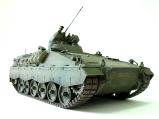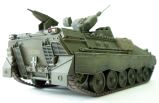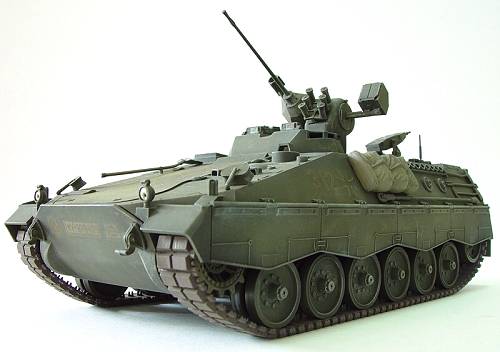Schützenpanzer
Marder
The Marder entered service in the early 1970s as the standard infantry
armored vehicle (Schützenpanzer) of the Bunderswehr (Federal German
Army). In concept it departed quite radically from the accepted ideas of
an armored infantry vehicle of the type developed in the 1950s and 1960s.
The original type of tracked infantry vehicle developed by the major
Western powers consisted basically of an armored box which transported an
infantry squad from point to point, where they then developed on foot to
use their weapons. This type of vehicle, the armored personnel carrier, is
typified by such well known designs as the US M113 and the British FV432.
These vehicles give good protection to the occupants from small arms fire,
explosions and even tactical nuclear attack, but no provision is made for
the infantrymen to use their weapons offensively or defensively from
inside the vehicle. Though versions of these early designs have since been
developed with small turrets and automatic guns, these are still largely
for self-defence.
 The
Marder differs from these. It makes provision for the infantrymen inside
to put up considerable firepower from the vehicle while on the move. It is
such a departure from previous practice, in fact, that within NATO it is
classed in a new category, MICV or Mechanized Infantry Combat Vehicle,
rather than an APC or Armored Personnel Carrier. The Marder was developed
and designed by the celebrated firm of Rheinstahl Henschel AG or Kassel,
who had built the Tiger and other famous AFVs in World War II. It was
intended to be just one of eight types in a so called "Leichten
Panzerfamilie" - light armor family, which was intended to have a
common range of automotive and structural components in the ever desirable
quest for standardization. The prototype Marder, initially called just
"Spz(neu) - Infantry Armored Vehicle - new, appeared in 1960-61
when six prototype were built. These closely resembled the HS 30 APC which
the Spz(neu) was intended to replace. There was a front mounted one-man
turret with 20mm automatic cannonand five road wheels each side, but the
motor was moved to the middle and right ( it has been at the rear in
the HS30) so that the occupants could then have a rear exit door. The
distinctive "stepped" front shape of the HS30 was repeated in
the HS30. By 1963 a second series of seven prototypes was put into
service, and here there came some radical changes. The
Marder differs from these. It makes provision for the infantrymen inside
to put up considerable firepower from the vehicle while on the move. It is
such a departure from previous practice, in fact, that within NATO it is
classed in a new category, MICV or Mechanized Infantry Combat Vehicle,
rather than an APC or Armored Personnel Carrier. The Marder was developed
and designed by the celebrated firm of Rheinstahl Henschel AG or Kassel,
who had built the Tiger and other famous AFVs in World War II. It was
intended to be just one of eight types in a so called "Leichten
Panzerfamilie" - light armor family, which was intended to have a
common range of automotive and structural components in the ever desirable
quest for standardization. The prototype Marder, initially called just
"Spz(neu) - Infantry Armored Vehicle - new, appeared in 1960-61
when six prototype were built. These closely resembled the HS 30 APC which
the Spz(neu) was intended to replace. There was a front mounted one-man
turret with 20mm automatic cannonand five road wheels each side, but the
motor was moved to the middle and right ( it has been at the rear in
the HS30) so that the occupants could then have a rear exit door. The
distinctive "stepped" front shape of the HS30 was repeated in
the HS30. By 1963 a second series of seven prototypes was put into
service, and here there came some radical changes. The five road wheels were replaced by six smaller ones each side, and the
engine was moved to a fore-end aft position at the extreme right front,
with transverse transmission driving front sprocket wheels. The third
series of six prototypes was used to evolve the definitive production
design, and these appeared in the 1963-65 period. The stepped front gave
way to sleek and graceful sloped front, and there was a low two man turret
with smoke dischargers and a rear cupola which
incorporated a remote control 7.62mm machine gun in a protected sleeve to
cover the rear flanks of the vehicle. It was not until 1966, however, that
the final transition to MICV form came. Until that time there was still no
provision for the occupants to fire their own side arms from within the
vehicle. But the fact that several types of Soviet APC had flaps or ports
enabling this to be done, probably influenced the decision. One
of the last group of prototypes was given two armored Ball type ports each
side from which fire arms could be fired over a wide side arc without
exposing the occupants themselves to fire. At the same time there appeared
a new low two man turret with the 20mm machine cannon set above it and a
7.62mm machine gun above that in an armored housing. All guns were fired
remotely from within the vehicle. Smoke discharges were set adjacent to
the 20mm gun mount.
The five road wheels were replaced by six smaller ones each side, and the
engine was moved to a fore-end aft position at the extreme right front,
with transverse transmission driving front sprocket wheels. The third
series of six prototypes was used to evolve the definitive production
design, and these appeared in the 1963-65 period. The stepped front gave
way to sleek and graceful sloped front, and there was a low two man turret
with smoke dischargers and a rear cupola which
incorporated a remote control 7.62mm machine gun in a protected sleeve to
cover the rear flanks of the vehicle. It was not until 1966, however, that
the final transition to MICV form came. Until that time there was still no
provision for the occupants to fire their own side arms from within the
vehicle. But the fact that several types of Soviet APC had flaps or ports
enabling this to be done, probably influenced the decision. One
of the last group of prototypes was given two armored Ball type ports each
side from which fire arms could be fired over a wide side arc without
exposing the occupants themselves to fire. At the same time there appeared
a new low two man turret with the 20mm machine cannon set above it and a
7.62mm machine gun above that in an armored housing. All guns were fired
remotely from within the vehicle. Smoke discharges were set adjacent to
the 20mm gun mount.
In this form the Marder started series production in April 1967, and has
seen wide spread service since. In best Henschel tradition it represents
high quality engineering. It carries a crew of ten, all with good access
hatches. The steep sloped armor affords excellent protection and it is a
very fast, a 600bhp Daimler-Benz diesel giving a top speed of 47 mph on
the road. Since it is very low and heavy (28 tons) for its size it cannot
swim like the boxy APCs of the Fv 432 type. Instead it relies on a snort
tube for river crossing of deep wading up to 16 feets. Side skirts to
cover the return rollers have been retrospective addition, and a recent
development has been the fitting of a Milan anti-tank missile launcher to
the right side of the gun mount, making this useful fighting vehicle even
more potent.
(From Tamiya Manual) |
Specification
:
Country of
Origin : 
Crew
: 3 + 6
Armament : 1x20mm cannon, 1x7.62mm MG (coaxial), 1x6 smoke
dischargers
Ammunition : 1,250 x 20mm, 5,000 x 7.62mm
Engine : MTU MB 333 Ea-500 6-cylinder liquid cooled diesel
developing 600 hp at 2,200 rpm |
|
Length
: 6.79m
Width : 3.24m
Height over turret Top : 2.985m
Power-to-weight ratio : 20.54hp/tonne
Maximum road speed : 75 km/hr
Fuel capacity : 652 lit.
Vertical obstacle : 1m
Trench : 2.5m
Armor : Classified
NBC system : Yes
Height
Hull top : 1.9m
Ground Clearance : 0.44m
Weight, combat : 29,200kg
Ground Pressure : 0.83kg/cm²
Maximum road range : 520 km
Fording : 1.5m, 2m with preparation
Gradient : 60%
Side slope : 30%
Armor type : steel
Night Vision Equipment : Yes
|
 |